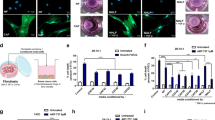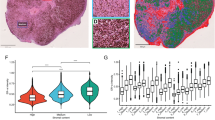Abstract
Tamoxifen resistance has been largely attributed to genetic alterations in the epithelial tumor cells themselves, such as overexpression of HER-2/Neu. However, in the clinic, only about 15–20% of cases of HER-2/Neu amplification has actually been correlated to the acquisition of endocrine resistance, suggesting that other mechanisms must be involved as well. Using the epithelial LM05-E and the fibroblastic LM05-F cell lines, derived from the estrogen dependent spontaneous M05 mouse mammary tumor, as well as MCF-7 cells, we analyzed whether soluble stromal factors or extracellular matrix components protected against tamoxifen induced cell death. Involvement of signaling pathways was determined by using specific inhibitors and western blot, and phosphorylation of the estrogen receptor alpha by western blot and immunofluorescence. Soluble factors produced by the fibroblastic cells protect the epithelial tumor cells from tamoxifen-induced cell death through a mechanism that involves EGFR and matrix metalloproteinases upstream of PI3K/AKT. Exogenous fibronectin by itself confers endocrine resistance through interaction with β1 integrin and activation of PI3K/AKT and MAPK/ERK 1/2 pathways. The conferred resistance is reversed by blocking β1 integrin. We show also that treatment with both conditioned medium and fibronectin leads to the phosphorylation of the estrogen receptor at serine-118, suggesting stromal factors as modulators of ER activity. Our results show that the tumor microenvironment can modulate tamoxifen resistance, providing an alternative explanation for why patients become refractory to hormone-therapy.








Similar content being viewed by others
Abbreviations
- MMP:
-
Matrix metalloproteinase
- ER:
-
Estrogen receptor
- FN:
-
Fibronectin
- FCM:
-
LM05-F conditioned medium
- NMC:
-
Non conditioned medium
- PI:
-
Propidium iodide
- DAPI:
-
4′,6-Diamino-2-phenylindole
- EGFR:
-
Epidermal growth factor receptor
- pSer-118 ER:
-
Phosphor-serine-118 ER
- ECM:
-
Extracellular matrix
- E2 :
-
Estradiol
- PD:
-
PD98059
- LY:
-
LY294002
- T:
-
4-OH-tamoxifen
References
Jordan C (2002) Historical perspective on hormonal therapy of advanced breast cancer. Clin Ther 24(Suppl A):A3–A16
Nahta R, Esteva FJ (2006) Herceptin: mechanisms of action and resistance. Cancer Lett 232:123–138
Slamon DJ, Godolphin W, Jones LA, Holt JA, Wong SG, Keith DE, Levin WJ, Stuart SG, Udove J, Ullrich A (1989) Studies of the HER-2/Neu proto-oncogene in human breast and ovarian cancer. Science 244:707–712
Dowsett M, Johnston S, Martin LA, Salter J, Hills M, Detre S, Gutierrez MC, Mohsin SK, Shou J, Allred DC, Schiff R, Osborne CK, Smith I (2005) Growth factor signalling and response to endocrine therapy: the Royal Marsden Experience. Endocr Relat Cancer 12(Suppl 1):S113–S117
Gutierrez MC, Detre S, Johnston S, Mohsin SK, Shou J, Allred DC, Schiff R, Osborne CK, Dowsett M (2005) Molecular changes in tamoxifen-resistant breast cancer: relationship between estrogen receptor, HER-2, and p38 mitogen-activated protein kinase. J Clin Oncol 23:2469–2476
Newby JC, Johnston SR, Smith IE, Dowsett M (1997) Expression of epidermal growth factor receptor and c-erbB2 during the development of tamoxifen resistance in human breast cancer. Clin Cancer Res 3:1643–1651
Bissell MJ, Radisky D (2001) Putting tumours in context. Nat Rev Cancer 1:46–54
Littlepage LE, Egeblad M, Werb Z (2005) Coevolution of cancer and stromal cellular responses. Cancer Cell 7:499–500
Tlsty T (2008) Cancer: whispering sweet somethings. Nature 453:604–605
Tlsty TD, Coussens LM (2006) Tumor stroma and regulation of cancer development. Annu Rev Pathol 1:119–150
Bergamaschi A, Tagliabue E, Sorlie T, Naume B, Triulzi T, Orlandi R, Russnes HG, Nesland JM, Tammi R, Auvinen P, Kosma VM, Menard S, Borresen-Dale AL (2008) Extracellular matrix signature identifies breast cancer subgroups with different clinical outcome. J Pathol 214:357–367
Finak G, Bertos N, Pepin F, Sadekova S, Souleimanova M, Zhao H, Chen H, Omeroglu G, Meterissian S, Omeroglu A, Hallett M, Park M (2008) Stromal gene expression predicts clinical outcome in breast cancer. Nat Med 14:518–527
Helleman J, Jansen MPHM, Ruigrok-Ritstier K, van Staveren IL, Look MP, Meijer-van Gelder ME, Sieuwerts AM, Klijn JGM, Sleijfer S, Foekens JA, Berns EMJJ (2008) Association of an extracellular matrix gene cluster with breast cancer prognosis and endocrine therapy response. Clin Cancer Res 14:5555–5564
Jansen MP, Foekens JA, van Staveren IL, Dirkzwager-Kiel MM, Ritstier K, Look MP, Meijer-van Gelder ME, Sieuwerts AM, Portengen H, Dorssers LC, Klijn JG, Berns EM (2005) Molecular classification of tamoxifen-resistant breast carcinomas by gene expression profiling. J Clin Oncol 23:732–740
Simian M, Manzur T, Rodriguez V, de Kier Joffe EB, Klein S (2009) A spontaneous estrogen dependent, tamoxifen sensitive mouse mammary tumor: a new model system to study hormone-responsiveness in immune competent mice. Breast Cancer Res Treat 113:1–8
Pontiggia O, Rodriguez V, Fabris V, Raffo D, Bumaschny V, Fiszman G, de Kier Joffe EB, Simian M (2009) Establishment of an in vitro estrogen-dependent mouse mammary tumor model: a new tool to understand estrogen responsiveness and development of tamoxifen resistance in the context of stromal-epithelial interactions. Breast Cancer Res Treat 116:247–255
Park CC, Zhang H, Pallavicini M, Gray JW, Baehner F, Park CJ, Bissell MJ (2006) Beta1 integrin inhibitory antibody induces apoptosis of breast cancer cells, inhibits growth, and distinguishes malignant from normal phenotype in three dimensional cultures and in vivo. Cancer Res 66:1526–1535
Simian M, Hirai Y, Navre M, Werb Z, Lochter A, Bissell MJ (2001) The interplay of matrix metalloproteinases, morphogens and growth factors is necessary for branching of mammary epithelial cells. Development 128:3117–3131
Sengupta S, Jordan VC (2008) Selective estrogen modulators as an anticancer tool: mechanisms of efficiency and resistance. Adv Exp Med Biol 630:206–219
Arpino G, Wiechmann L, Osborne CK, Schiff R (2008) Crosstalk between the estrogen receptor and the HER tyrosine kinase receptor family: molecular mechanism and clinical implications for endocrine therapy resistance. Endocr Rev 29:217–233
Kurokawa H, Arteaga CL (2003) ErbB (HER) receptors can abrogate antiestrogen action in human breast cancer by multiple signaling mechanisms. Clin Cancer Res 9:511S–515S
Yu WH, Woessner JF Jr, McNeish JD, Stamenkovic I (2002) CD44 anchors the assembly of matrilysin/MMP-7 with heparin-binding epidermal growth factor precursor and ErbB4 and regulates female reproductive organ remodeling. Genes Dev 16:307–323
Wang F, Weaver VM, Petersen OW, Larabell CA, Dedhar S, Briand P, Lupu R, Bissell MJ (1998) Reciprocal interactions between beta1-integrin and epidermal growth factor receptor in three-dimensional basement membrane breast cultures: a different perspective in epithelial biology. Proc Natl Acad Sci USA 95:14821–14826
Massarweh S, Schiff R (2006) Resistance to endocrine therapy in breast cancer: exploiting estrogen receptor/growth factor signaling crosstalk. Endocr Relat Cancer 13(Suppl 1):S15–S24
Kalluri R, Zeisberg M (2006) Fibroblasts in cancer. Nat Rev Cancer 6:392–401
Koshikawa N, Schenk S, Moeckel G, Sharabi A, Miyazaki K, Gardner H, Zent R, Quaranta V (2004) Proteolytic processing of laminin-5 by MT1-MMP in tissues and its effects on epithelial cell morphology. FASEB J 18:364–366
Chabottaux V, Noel A (2007) Breast cancer progression: insights into multifaceted matrix metalloproteinases. Clin Exp Metastasis 24:647–656
Lochter A, Galosy S, Muschler J, Freedman N, Werb Z, Bissell MJ (1997) Matrix metalloproteinase stromelysin-1 triggers a cascade of molecular alterations that leads to stable epithelial-to-mesenchymal conversion and a premalignant phenotype in mammary epithelial cells. J Cell Biol 139:1861–1872
Arpino G, Green SJ, Allred DC, Lew D, Martino S, Osborne CK, Elledge RM (2004) HER-2 amplification, HER-1 expression, and tamoxifen response in estrogen receptor-positive metastatic breast cancer: a southwest oncology group study. Clin Cancer Res 10:5670–5676
Shekhar MP, Santner S, Carolin KA, Tait L (2007) Direct involvement of breast tumor fibroblasts in the modulation of tamoxifen sensitivity. Am J Pathol 170:1546–1560
Woodward TL, Lu H, Haslam SZ (2000) Laminin inhibits estrogen action in human breast cancer cells. Endocrinology 141:2814–2821
Hiscox S, Barnfather P, Hayes E, Bramble P, Christensen J, Nicholson RI, Barrett-Lee P (2011) Inhibition of focal adhesion kinase suppresses the adverse phenotype of endocrine-resistant breast cancer cells and improves endocrine response in endocrine-sensitive cells. Breast Cancer Res Treat 125:659–669
Jia Y, Zeng ZZ, Markwart SM, Rockwood KF, Woods Ignatoski KM, Ethier SP, Livant DL (2004) Integrin fibronectin receptors in matrix metalloproteinase-1-dependent invasion by breast cancer and mammary epithelial cells. Cancer Res 64:8674–8681
Aoudjit F, Vuori K (2001) Integrin signaling inhibits paclitaxel-induced apoptosis in breast cancer cells. Oncogene 20:4995–5004
Damiano JS, Cress AE, Hazlehurst LA, Shtil AA, Dalton WS (1999) Cell adhesion mediated drug resistance (CAM-DR): role of integrins and resistance to apoptosis in human myeloma cell lines. Blood 93:1658–1667
Uhm JH, Dooley NP, Kyritsis AP, Rao JS, Gladson CL (1999) Vitronectin, a glioma-derived extracellular matrix protein, protects tumor cells from apoptotic death. Clin Cancer Res 5:1587–1594
Hodkinson PS, MacKinnon AC, Sethi T (2007) Extracellular matrix regulation of drug resistance in small-cell lung cancer. Int J Radiat Biol 83:733–741
Yao ES, Zhang H, Chen YY, Lee B, Chew K, Moore D, Park C (2007) Increased beta1 integrin is associated with decreased survival in invasive breast cancer. Cancer Res 67:659–664
Murphy LC, Weitsman GE, Skliris GP, Teh EM, Li L, Peng B, Davie JR, Ung K, Niu YL, Troup S, Tomes L, Watson PH (2006) Potential role of estrogen receptor alpha (ERalpha) phosphorylated at Serine118 in human breast cancer in vivo. J Steroid Biochem Mol Biol 102:139–146
Acknowledgments
Financial support: MS work is supported by a Grant from the Susan G. Komen for the Cure Foundation (BCTR0600341) and ANPCyT (PICT2008-0325/Préstamo BID); EBKJ by ANPCyT (PICT 00417/Préstamo BID) and UBACyT (M003). MJB’s laboratory is supported by grants from the U.S. Department of Energy, OBER Office of Biological and Environmental Research (DE-AC02-05CH1123), a Distinguished Fellow Award and Low Dose Radiation Program and the Office of Health and Environmental Research, Health Effects Division, (03-76SF00098); by National Cancer Institute awards 5 R01CA064786, R01CA057621, U54CA126552 and U54CA112970; by U.S. Department of Defense (W81XWH0810736).
Conflict of interest
The authors declare they have no competing interests.
Author information
Authors and Affiliations
Corresponding author
Additional information
M. Simian and E. B. de Kier Joffé are members of the Research Career, Consejo Nacional de Investigaciones Científicas y Técnicas.
Electronic supplementary material
Below is the link to the electronic supplementary material.
Supplementary Fig. 1
LM05-E cells were starved for 48 h and then treated for 1 h with either vehicle, the PI3K/AKT inhibitor LY294002 (LY; 10 μM) (a), the MAPK/ERK inhibitor PD98059 (PD; 10 μM) (b) or the EGFR inhibitor AG1478 (AG; 6.4 μM) (c). At that time they were treated or not for 10 min with FCM. Samples were processed for western blot. As shown the three inhibitors were effective at the concentrations used. d LM05-E cells were plated on FN and treated with 10 nM estradiol (E2) or estradiol plus the PI3K/AKT inhibitor LY294002 (LY) or the MAPK/ERK inhibitor PD98059 (PD), both at a 10 μM concentration. Under these experimental conditions none of the inhibitors induced cell death (TIFF 2913 kb)
Rights and permissions
About this article
Cite this article
Pontiggia, O., Sampayo, R., Raffo, D. et al. The tumor microenvironment modulates tamoxifen resistance in breast cancer: a role for soluble stromal factors and fibronectin through β1 integrin. Breast Cancer Res Treat 133, 459–471 (2012). https://doi.org/10.1007/s10549-011-1766-x
Received:
Accepted:
Published:
Issue Date:
DOI: https://doi.org/10.1007/s10549-011-1766-x




